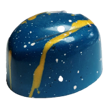I'll bet you hit it on the head, and it just took the freezer a long time to recover from defrosting. It can take a fridge / freezer 24 hours just to stabilize after changing the thermostat setting. Not sure why it takes so long.
Ideal freezer temperature is a tricky issue, since at home we use the same freezer for hardening, for storage, and for serving.
According to Dr. Cesar Vega, the ideal hardening cabinet is -33°C / -27°F. Most actual hardening cabinets are -40, and conventional wisdom is that the colder the better, but Vega says (somewhere) that if you freeze ice cream too cold, the water turns to water glass, rather than crystalline ice, and this can lead to large crystals forming when it warms up. But most of us don't have to face this problem.
For storage, he says typical ice creams are completely stable at -25°C / -13°F or below. Ice crystals won't grow, because all the water is solid.
For serving, standard practice is -14 to -12°C / 6 to 10° F. Ice cream shop scooping cabinets are probably somewhere around there. Too warm for everything else you use a freezer for.
In my experience, -20C / -5°F worked well for everything. It was the coldest my old freezer would go, so I couldn't compare lower temps. It hardened the ice cream quickly and gave great texture, and the ice cream only took a few minutes to soften after you pulled it out. The only drawback I found was energy use. It wasn't the newest of fridges and you could tell it was cycling on a lot.
Edited to add
I've looked into the idea that a hardening cabinet shouldn't be colder than 33°, and don't think there's anything to back it up. In order for water to form a glass (amorphous ice) it has to freeze to a temperature lower than this in milliseconds. Which is not going to happen when you put a pint container into the freezer. This is something you might think about when making liquid nitrogen ice cream (and it's the whole idea behind dippin' dots).
Probably the conventional wisdom is right, and colder is better in a blast freezer.




